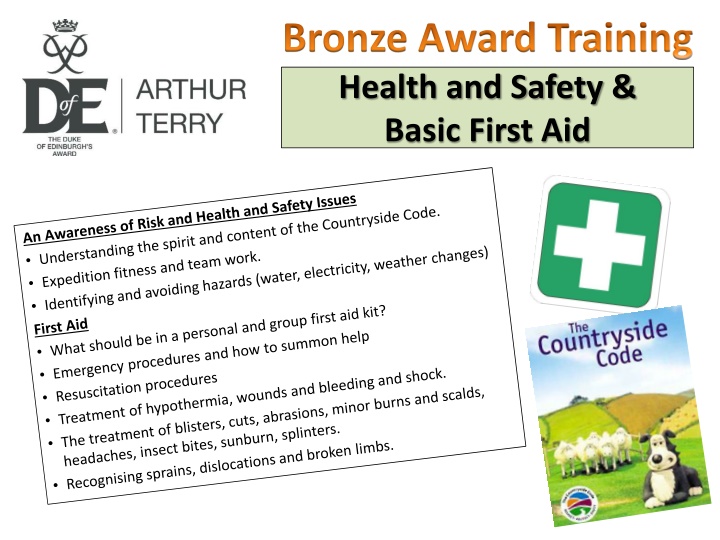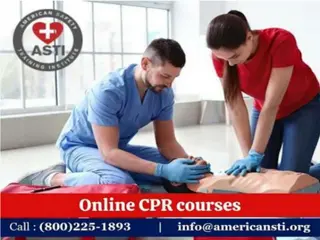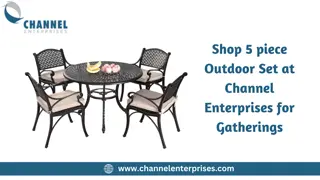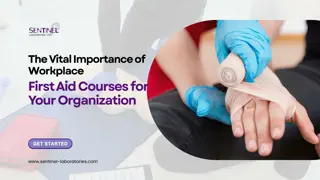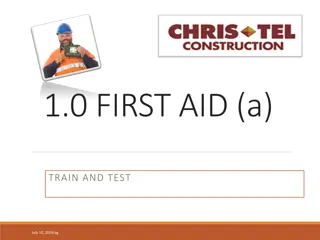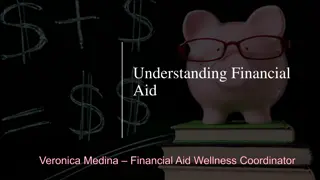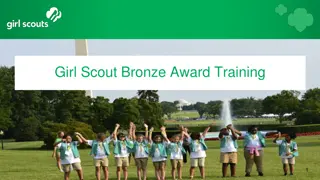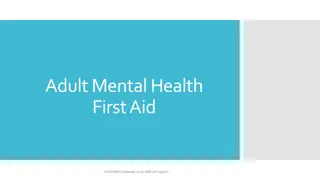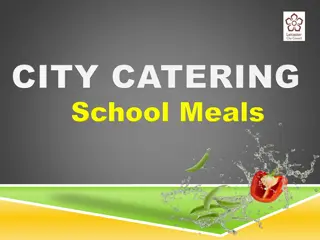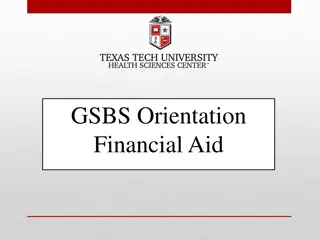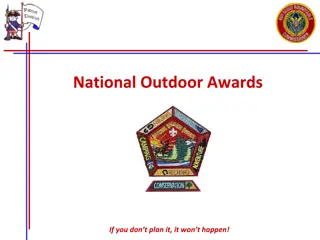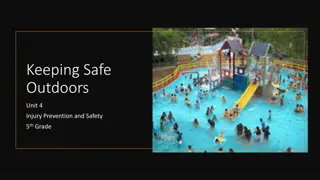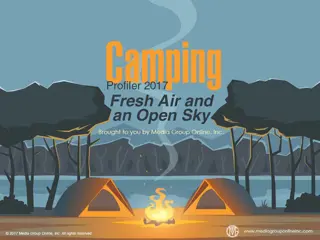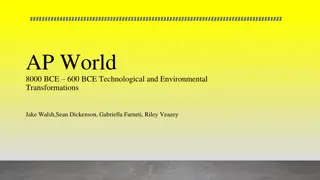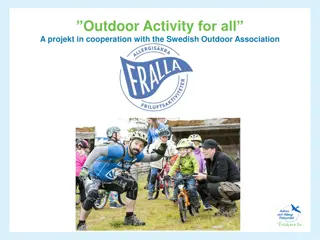Outdoor Bronze Award Training: Health, Safety, and First Aid Guidelines
This comprehensive guide outlines essential tips for safe outdoor activities, emphasizing respect for nature, teamwork, and hazard awareness. It covers topics such as navigation, fitness, avoiding trouble, and what to do if lost. Stay informed on how to take care of yourself and your group while exploring the great outdoors effectively.
Download Presentation

Please find below an Image/Link to download the presentation.
The content on the website is provided AS IS for your information and personal use only. It may not be sold, licensed, or shared on other websites without obtaining consent from the author.If you encounter any issues during the download, it is possible that the publisher has removed the file from their server.
You are allowed to download the files provided on this website for personal or commercial use, subject to the condition that they are used lawfully. All files are the property of their respective owners.
The content on the website is provided AS IS for your information and personal use only. It may not be sold, licensed, or shared on other websites without obtaining consent from the author.
E N D
Presentation Transcript
Bronze Award Training Health and Safety & Basic First Aid
1. Follow local signs, advice and access restrictions don t stray off footpaths or enter private property. Leave gates and property as you find them always close gates behind you. Litter can be dangerous to wildlife and farm animals - take all rubbish with you. Don't damage or remove rocks, plants or trees - they are homes and food for insects, birds and animals. Wild animals and farm animals can behave unpredictably, especially if they're with their young, so give them plenty of space and stay quiet. 2. 3. 4. 5. Other important points: Always walk towards oncoming traffic in single file on roads (on the right-hand side of the road). Keep away from the edges of cliffs (obviously!) Only cross rivers at fords or on stable bridges. Only cross railway lines on marked crossings. Never start a fire in the countryside. Don t contaminate fresh water. Don t make unnecessary noise that will disturb other people or animals. Mobiles and Music Mobile phones and MP3 players are strictly not allowed on expeditions. One designated person can carry a mobile phone in a sealed plastic bag (only they should bring one and KNOW THEIR NUMBER PLEASE!!)
Fitness and Teamwork You are part of a group and should support each other at all times. You should ALL take turns at map reading AND ideally ALL of you should know where you are at ALL times. Check with each other when navigating. Be sensitive to people with different levels of fitness If someone wants to stop and is very tired, have a short break. Encourage and motivate weaker walkers into keeping going and keep the stronger walkers at the back. NEVER lose sight of any of your group. You ALL must start, progress and finish together to pass the expedition. NEVER leave a member of your group alone under any circumstances.
Avoiding Trouble TOP TIPS Hazards Stick to your route closely. Be particularly aware when near water, railways, roads, shooting ranges and quarries. Don t touch or try to climb electric fences. Wear plenty of sunblock and a wide-brimmed hat to avoid sunburn/heatstroke. Drink lots of water (little and often) to avoid dehydration. Do not accept lifts from strangers or go into people s homes under any circumstances. The weather Check the weather forecasts before you go. Look for signs which will indicate changes in the weather eg. Put on waterproofs when clouds go black. Lightning Stay away from trees, summits and ridges, sit down on your kip mat/rucksack with your feet off the floor, hands folded in front and tucked in OR get in a tent or minibus if you are at camp. Wind chill cant be underestimated. Strong winds are tiring and drive rain into clothes and tents. Don t pitch a tent side-on to the wind it will blow away!
If you get lost: Don t panic! If you know where you are on the map, plan a new route to your checkpoint OR retrace your steps and get back on your route OR head for a collecting feature (road, river) or follow a natural feature (eg. A valley, stream) likely to lead to habitation go downhill, not up!! You wont fail an expedition for getting lost but you have to correct yourself quickly. You will not pass the expedition if you run out of time or energy or cant correct yourselves when lost. Don t phone us unless absolutely necessary if you do, we need a calm and mature conversation with one person! Hi Sir, its me ! Its Jamie Smith from group 12. We left a village about 10 minutes ago and walked north up the road for about 2km then took a footpath East. After about 20 minutes in the same direction we aren t sure where we are. Our last known grid reference was 238-358. We think we might be at 257-342 at the moment. We are lost in a field ..there are cows. I can see some trees. Do you know where we are? (we get this a lot!!)
What do you need in a First Aid kit? Group Items (decide who gets what) Sterile wound dressings Triangular bandage Crepe bandage Micropore tape Safety pins Small scissors Tweezers Disposable plastic gloves Anti-histamine cream Personal items Blister plasters Painkillers (for you only!) Plasters Antiseptic wipes/cream Insect repellent & sun cream Antihistamine tablets (for hay fever) We also have all of the above and more on the minibus !!
As a group, Decide on what you think you should do for each of these
Minor cuts and bleeds Serious bleeding and shock (blood loss) Sprains Suspected break or dislocation Minor Burns Serious burns Hyperthermia/heat stroke Hypothermia Blisters
Treatments you can do Bleeding and cuts Cover up, drink lots and apply Calamine lotion or after sun Run under cold water for 2 minutes then submerge for 10 minutes and cover with a sterile dressing Drink plenty, keep out of the sun, put a cold wet cloth on your head and take painkillers Use antiseptic cream/anti-histamine cream. Clean area with an antiseptic wipe, use tweezers to remove it, then use antiseptic cream and cover with a plaster. Wash and carefully dry the area and apply special gel plasters. Don t burst them Clean with antiseptic wipe and cover with a plaster Can you correctly match these up ? Blisters Burns/scalds Headaches Splinters Insect bites Sunburn
You need to call us ! If any of the previous things are getting worse or your treatment doesn t help Heat Exhaustion & Heatstroke This isn t just sunburn, in fact they might not be visibly sunburnt. It is extreme dehydration due to lack of water and extreme overheating. Look for confusion, restlessness and feeling sick and cold, although they are hot. Get them somewhere cool, remove excessive clothing and give plenty of water contact us. If it gets worse or they stop sweating and have a fast and strong pulse, call 999. Sprains (probably not a 999 call, unless a suspected break or dislocation, but definitely call us!) Support the person s weight. Don t take off their boot, you might not be able to put it back on due to swelling you might want to put the whole ankle and boot into a stream. RICE Rest Ice pack or cold wet compress to reduce swelling Compression use a crepe bandage Elevate to reduce swelling Hyperventilation Deep, fast breathing and possible dizziness caused by anxiety. Sit them down in a quiet place and calmly tell them to breathe slowly, perhaps taking tiny sips of water. Asthma Look for difficulty breathing and speaking and wheezing noises. Sit them upright and be calm and reassuring help give their reliever inhaler (blue) and keep them warm. If they get worse then call 999. Fainting They may be feeling sick, dizzy and have blurred vision. Their skin might be pale and clammy. Lie them down in a quiet place and raise their legs talk to them calmly
What if its more serious ? All 999 calls ! Dislocations and Breaks - 999 Look for swelling, bruising, bone piercing the skin or deformity. Check with casualty if in pain, hearing a snap or grating noise. Immobilise the limb but don t move the casualty (use a sling or splint if you can but really you need training for this) Do not put them in the recovery position unless they stop breathing it might make it worse. NEVER move someone with a suspected fractured spine. Do not give food or drink to someone you expect will need anaesthetic Major Burns - 999 Douse affected area in lots of cold water for at least 10 minutes. Don t remove clothing sticking to the burn. Make a clean covering for the burn (plastic bag, sterile triangular bandage). Don t burst any blisters. Hypothermia - 999 Look out for fatigue, pale skin, shivering, confusion, irrational or violent behaviour, loss of consciousness (casualties can go into a coma and even die from this) Find shelter and give them lots of layers of spare dry clothes, insulate from the ground with a kip mat and put them in a sleeping bag (with someone else to warm them up!!). Give sips of hot, sweet drinks then chocolate for energy if they improve. Check the pulse DO NOT rub the casualty s skin or give alcohol. Serious bleeding - 999 Apply lots of direct pressure using a wound dressing if possible. You may have to push together the sides of an open wound. Elevate the wound above the level of the heart if possible. Do not remove a dressing. If blood seeps through, put another dressing on top. Shock (due to blood loss) - 999 Look for cold, clammy skin, rapid shallow breathing and blue lips. They may feel sick, faint or weak and dizzy. Their pulse will be fast and weak. Lie down the casualty and raise their legs at least 25cm, loosen tight clothing and keep them warm with clothing. Do not give food or drink as this might cause vomiting Call 999. Serious allergy (anaphylaxis) 999 A bee sting or nut allergy or something else can cause this and its life threatening. Look for swelling and difficulty breathing but there are other symptoms. Lie them down and raise their legs. If they have an Epipen you can give it if they are unable to. TAKE OFF THE CAP, GRAB THE CYLINDER (NOT THE END) AND THRUST INTO THE THIGH (THROUGH CLOTHES) AND HOLD IN PLACE FOR 10 SECONDS
Heeeelllllllppp ! If someone gets into trouble or is hurt...... Don t panic, stay calm! Make sure no one else is at risk and give first aid if needed. Prepare a written message (see next page) You must always stay together as a group unless there is an emergency where you need to go for help (TWO people go, the rest stay with the casualty why?) People staying with the casualty Continue first aid Protect yourselves from the weather (flysheet, survival bag) Reassure and comfort the casualty Make yourselves easily visible Be prepared to lead rescuers back People going for help Call for assistance as soon as you have a mobile signal. Aim for the nearest road, house, farm etc. to be able to make a call if there is no mobile signal. In a serious emergency CALL 999 FIRST !!! Then the school mobile/campsite. If it s a minor emergency (eg. A sprain) then call the school mobile/campsite, or go back to a checkpoint. Wait by the phone for further instructions (don t go back to the group unless told to)
Preparing a Written Message Arthur Terry School Duke of Edinburgh EMERGENCY MESSAGE Location of incident (6 fig grid ref) Time of incident Injured person s name Nature of injuries Start and finish point of your route Other group members It is important that you write down this information before going for help because: You might forget some details when you find help If someone is bleeding heavily or unconscious, emergency services will need to know how long ago the incident was and where exactly the casualty is. You might become injured too on the way THE INTERNATIONAL DISTRESS SIGNAL 6 long blasts on a whistle or long flashes of a torch wait one minute and repeat The reply will be 3 whistle blasts or flashes a minute apart Keep doing it, even after a reply so you can be located easily
Your ABCD Accident Protocol Assess Check the area is safe, don t go to the casualty if it isn t your safety is more important than theirs. Alertness Ask them to respond and say who you are. Give a verbal command open your eyes . Check for a physical response tap their shoulders. Airway Tip their head back and push up their chin to ensure their airway is clear. Breathing Listen at their mouth, look at their chest and feel it too. Circulation Check for obvious bleeding. Check behind the neck, abdomen and knees for pools of blood Discovery Head (skull, ears, pupils) Neck Shoulders Chest Abdomen (4 quadrants) Legs and ankles (check both at the same time) Arms (check both at the same time) SAFE AIRWAY POSITION What is this and why do it? Not breathing, call 999/go and get help These are things to put in a written message unresponsive, non- breathing casualty with severe bleed to the head
CPR This is only to save a life and when there is no other option of immediate help and a casualty is not breathing. Few people survive unfortunately. Pinch nostrils shut. You take a full breath then seal your mouth around the casualty s mouth and blow for 2 seconds. Remove lips and let their chest fall. Repeat again. Must be lying on their back on a flat, firm surface. Kneel beside them. Place the heel of your hand between the nipples on the breastbone. Interlock fingers on your other hand and keep your arms straight. Press down vertically on the breastbone (it needs to go down 4-5cm) Release the pressure without moving your hands 30 times then 2 breaths again. Keep going until you cant do anymore (alternate with a partner if you can) Remember this is only to be used if a casualty is not breathing or breathing is irregular If doing this alone do 30 compressions then 2 breaths per minute, if in a pair swap over every two minutes When breathing returns, put them in the safe airway position. Going for help is first priority before doing any of this When you do, ask for an AED (defibrillator) to be sent with help
Case Studies what would you do ? 1. Jane begins shivering uncontrollably on a wet and windy mountain near to a sheltered cave. She appears confused. Your group are deep in a forest when a there are several loud claps of thunder. There is a clearing nearby. A member of your group trips and falls 5 metres down an embankment. He says it hurts and there is visible swelling of his ankle. He doesn t know if he has broken any bones and neither do you. Your group is lost and there is no sign of habitation nearby. There is a small stream at the bottom of a valley below. A member of your team cuts her arm on barbed wire and is bleeding quite heavily. 1. Send someone for help and call 999. Shelter in the cave and give her lots of layers of spare dry clothes, insulate from the ground with a kip mat and put her in a sleeping bag (with you!!). Boil some water and make her a sweet hot chocolate. DO NOT rub her skin. 2. 2. Head for the clearing, sit down on your kip mat/rucksack with your feet off the floor, hands folded in front and tucked in, until it seems to ease. 3. 3. Treat as a fracture NOT a sprain! Go for help call 999. Immobilise the limb. Check for any further pain and do not move them. 4. If it is not dangerous to travel down (no rock climbing!) move towards the stream and head downstream. If necessary and if getting dark, pitch your tent in a suitable spot. Keep checking for mobile phone signal. 4. 5. Clean the wound if you can. Apply direct pressure using a wound dressing and elevate the wound above the level of the heart. If blood seeps through, put another dressing on top. Look for signs of shock. Lie her down and raise her legs, loosen tight clothing and keep her warm. Do not give her give food or drink. Go for help. 5.
If time Try Triangular bandage tying Collar and cuff Bandanas Horizontal slings Elevation slings
Arthur Terry School Duke of Edinburgh EMERGENCY MESSAGE Location of incident (6 fig grid ref) Time of incident Injured person s name Nature of injuries Start and finish point of your route Other group members Arthur Terry School Duke of Edinburgh EMERGENCY MESSAGE Location of incident (6 fig grid ref) Time of incident Injured person s name Nature of injuries Start and finish point of your route Other group members
Case Studies 1. Jane begins shivering uncontrollably on a wet and windy mountain near to a sheltered cave. She appears confused. 2. Your group are deep in a forest when a there are several loud claps of thunder. There is a clearing nearby. 3. A member of your group trips and falls 5 metres down an embankment. He says it hurts and there is visible swelling of his ankle. He doesn t know if he has broken any bones and neither do you. 4. Your group is lost and there is no sign of habitation nearby. There is a small stream at the bottom of a valley below. 5. A member of your team cuts her arm on barbed wire and is bleeding quite heavily.
Next year For Silver Award students we are planning to run a 12 week first aid course that you can use for your Skill section !
